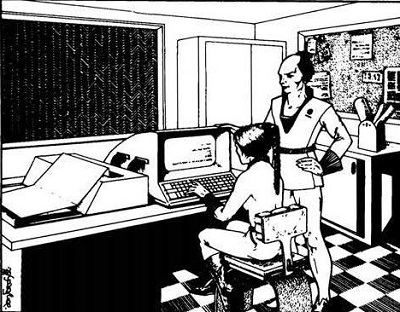Fiber Optic Computer
A Fiber Optic Computer, also notated as Fibre Optic Computer, is a computer whose logic circuits are constructed from fibre optic conduits. Such computers are less vulnerable to radiation effects than normal electronic computers and for this reason are often as a ship's computer on military vessels.
Description (Specifications)[edit]
A Ship’s Computer controls the maneuver and jump drives, and conducts the routine operation of all ship systems. What the computer actually does is based on the programs actually installed and operating at any one time.
Imperial ship designs, especially military vessels, use a fiber optic computer as a backup system (noted as fib in the description) in case of radiation damage. In addition from the normal radiation sources found in space the military ships face potential additional radiation exposure from weapons. Doctrine for other naval forces, for example the Darrian Navy, the fiber optic circuit computer is the primary computer system for starship operations.
Selected Ship's Computer Types[edit]
- Model/1 Computer (including the Model/1fib and the Model/1bis)
- Model/2 Computer (including the Model/2fib and the Model/2bis)
- Model/3 Computer (including the Model/3fib)
- Model/4 Computer (including the Model/4fib)
- Model/5 Computer (including the Model/5fib)
- Model/6 Computer (including the Model/6fib)
- Model/7 Computer (including the Model/7fib)
- Model/8 Computer (including the Model/8fib)
- Model/9 Computer (including the Model/9fib)
History & Background (Dossier)[edit]
Hard radiation is a serious problem in deep space, or even with interplanetary space, the stellar system. It wreaks havoc on electronics, especially conventional electronics. Fiber Optic Computers were one of the solutions to avoid the from radiation in deep space and have continuing computer operations.
See also[edit]
Computer design[edit]
Expected Computer Development Sequence[edit]
MACRO LEVEL:
- Compass → Astrolabe → Sextant → Analog Computer → Electromechanical Computer → Electronic Computer → Positronic Computer → Pseudo-Reality Computer → Psychotronic Computer
References & Contributors (Sources)[edit]
- Marc Miller, Frank Chadwick, John Harshman. High Guard (Game Designers Workshop, 1980), 21-22, 28.
- Jordan Weisman. "Book 2." Adventure Class Ships Volume 1 (1982): 3-4.
- Frank Chadwick, John Harshman, J. Andrew Keith, Marc Miller, Loren Wiseman. The Traveller Adventure (Game Designers Workshop, 1983), 142.
- J. Andrew Keith, Marc Miller, John Harshman. Droyne (Game Designers Workshop, 1985), 5.
- Marc W. Miller, Robert Parker, Nancy Parker, Matt Renner. Darrians (Game Designers Workshop, 1987), 18.
- Frank Chadwick, Dave Nilsen. Fire, Fusion, & Steel (Game Designers Workshop, 1994), 48.
- Colin Dunn. Library Data (Mongoose Publishing, 2011), 21.
- Matthew Sprange. High Guard (Mongoose Publishing, 2016), 18,26,56.
- Marc Miller, Robert Eaglestone, Don McKinney. Starships (Far Future Enterprises, 2019), 250.
